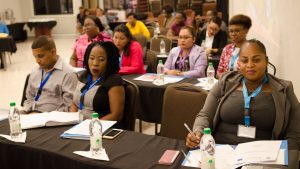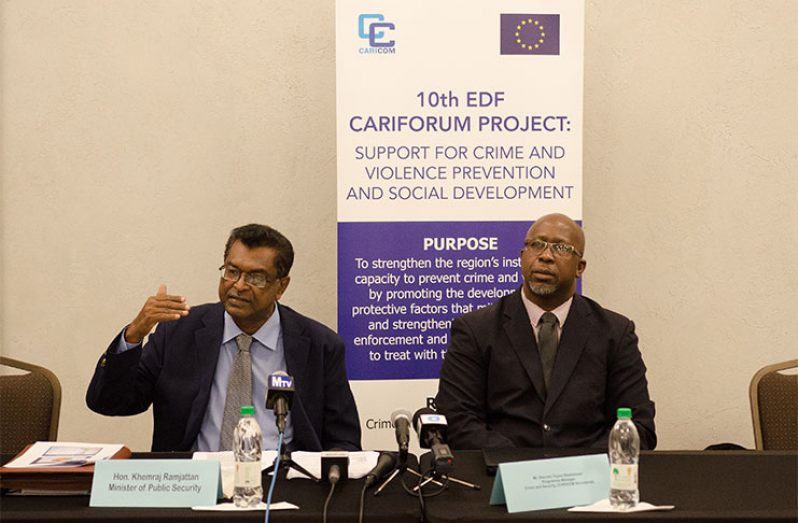By Tamika Garnett
SOME 50 stakeholders on Thursday met to craft an action plan to tackle crime and violence in primary schools and drug demand at the secondary level.
The two-day forum titled ‘National Consultation to Agree on a Crime and Violence Prevention and Mitigation’ is being held at Roraima Duke Lodge, Kingston, Georgetown.
The consultation is a follow up of assessments on research surveys done earlier this year at a number of primary and secondary schools across Guyana.
The programme is being funded by the European Union (EU) as a component of the 10th European Development Fund Crime and Violence Prevention and Social Development Project, and is fifth consultation held across five Caribbean countries. Consultations were also held in Antigua and Barbuda, Jamaica, Saint Lucia and Suriname.
It was decided that focus be placed on primary schools after the need was indicated following the end of a pilot project to reduce youth-on-youth violence, particularly in secondary schools across the five CARICOM member states.
“Reports indicate that Latin America and the Caribbean have literally reached epidemic proportions as it relates to gangs and organised crimes and the profit behind it. All of these indicate that the high rise of crime has direct effects on human welfare, and economic growth and development,” said Public Security Minister, Khemraj Ramjattan, who delivered remarks at the opening of the forum on Thursday.
“The objective of this broader activity under which the assessments fall is to build a capacity of schools teachers, counsellors, administrators and community leaders, for, what is called and is greatly being recognised as the way to go, evidence-based interventions to address crime and violence in primary and secondary schools and the related communities they are in.”
The assessment of the schools were carried out during February-March 2019 and targeted primary schools from several areas across the country, while the secondary schools were mainly from the Georgetown area.
A rapid assessment of risks, threats and protective factors was done in primary schools, while drug demand reduction was done in the secondary schools across five CARICOM member states.
“The primary schools included schools from Essequibo, East Coast, New Amsterdam, Linden and Georgetown and we had a number of primary school students surveyed, it came up to just over 400 students. In relation to the drug demand reduction survey, secondary schools surveyed were from the Georgetown area,” Ramjattan explained.
SERIOUS CONCERN

Over the years, research has concluded that crime and violence in Latin America and the Caribbean have increased continuously over the past two decades, threatening the security and welfare and development of the countries.
The United Nations Office on Drugs and Crime reported that in 2007, Latin America and the Caribbean had the highest murder rate in the world.
In Guyana, crime, violence and drug use in schools have been gaining increasing attention over the past few years. In January of this year, the suicide of a female private school student was linked to an organised ring engaged in trafficking of the date-rape drug, ecstasy. The student is said to have killed herself after the drug was found in her bag. The ring was uncovered by ‘D’ Division police in February.
Since last year, the Customs Anti-Narcotics Unit registered its worry over the trend of ecstasy being sold to students at a number of secondary schools across Regions Three and Four.
Violence in schools has also increased in attention. In Berbice, last year, there were two separate reported incidents of teachers being assaulted by students at the Number Eight Secondary School on the West Coast of Berbice. Also in Berbice earlier this year, a principal was assaulted by a student at a New Amsterdam school.
In March, a shocking video surfaced of a New Amsterdam Technical Institute student beating three other students with his fist and a belt. Over the years, there have also been reports of teachers and students being assaulted by other students.
BROKEN JAW
Last year February, in Essequibo, a student had to undergo emergency surgery for a broken jaw sustained during a fight with another student.
“For a while now it has been recognised that crime and violence is a development issue. The analysis implies that policies to reduce crime should focus on improving economic condition, providing opportunities for young people, especially males, and improving trust in law enforcement,” Ramjattan noted.
He added, “It is clear that the multidimensional nature and impact of drug use on the economy, on families, on health and wellbeing, on safety and security of the citizens necessitate the engagement of a number of sectors. That’s why we’re here, health, education, justice and social welfare, to address problems associated with the use of illicit drugs and alcohol in schools.”
Ramjattan noted that it is most laudable that the programme sees policies being crafted founded on evidence-based analysis, and not just assumptions.
“Research surveys are imperative in that evidence-based policy making can help government chart their way to a sustained growth path, coherent policies, and more effective policies that can lead to regulations that allow government to take account of pertinent information for more informed decision,” the minister said.
“This is a real huge development in my opinion and it is going to go a far way in prevention. Crime and violence prevention training opportunities will also be made available to parents, community leaders and other persons, and institutions working with in-school and out-of-school students to help in mentoring and facilitating development of positive social norms and values in these vulnerable communities.”
Among the initiatives expected to come out of the programme is a “Champions for Change” club initiative.
“The incorporation of ‘Champions for Change’ clubs and after school programmes will engage our target population in positive and rewarding activities and concurrently increase the social capital of participants. It is anticipated that a cadre of teacher, counsellors and community leaders from each target member country, will all be trained in developing a scheme of activities, planning and running the scheme of activities, problem solving and the management of resources related to the establishment of these clubs,” Ramjattan explained.




.jpg)









